Optimization of External Environment Design for Libraries in Hot and Dry Regions during Summer
Abstract
1. Introduction
2. Materials and Methods
2.1. Study Location
2.2. Questionnaire Survey
2.3. Field Measurements
2.3.1. Monitoring Point Layout
2.3.2. Monitoring Indicators and Methods
2.4. Software Simulation
2.4.1. ENVI-Met Modeling and Boundary Condition Settings
2.4.2. Selection of Evaluation Indicators
2.4.3. Simulation Scheme Design
3. Results and Discussion
3.1. Questionnaire Analysis
3.2. Analysis of Field Measurements
3.2.1. Air Temperature (Ta) and Relative Humidity (RH)
3.2.2. Solar Radiation (G) and Black Globe Temperature (Tg)
3.2.3. Wind Speed (Va) and Physiological Equivalent Temperature (PET)
3.2.4. Pearson Correlation Analysis
3.3. Analysis of Simulation Results
3.3.1. Validation of ENVI-Met Model Accuracy
3.3.2. Analysis of Simulation Schemes
- Orthogonal Experimental Simulation Scheme Analysis
- 2.
- Analysis of the Best PET Scenario
4. Conclusions
Supplementary Materials
Author Contributions
Funding
Data Availability Statement
Acknowledgments
Conflicts of Interest
Nomenclature
| Ta | Air temperature | G | Solar radiation |
| RH | Relative humidity | Va | Wind speed |
| Tmrt | Mean radiant temperature | TSV | Thermal sensation vote |
| Tg | Global temperature | TCV | Thermal comfort vote |
| SVF | Sky view factor | TAV | Thermal acceptability vote |
| PET | Physiological equivalent temperature | PMV | Predicted mean vote |
| UTCI | Universal thermal climate index | SET | Standard effective temperature |
References
- Mallen, E.; Bakin, J.; Stone, B.; Sivakumar, R.; Lanza, K. Thermal impacts of built and vegetated environments on local microclimates in an Urban University campus. Urban Clim. 2020, 32, 100640. [Google Scholar] [CrossRef]
- Duan, S.; Luo, Z.; Yang, X.; Li, Y. The impact of building operations on urban heat/cool islands under urban densification: A comparison between naturally-ventilated and air-conditioned buildings. Appl. Energy 2019, 235, 129–138. [Google Scholar] [CrossRef]
- Jaradat, H.; Alshboul, O.A.M.; Obeidat, I.M.; Zoubi, M.K. Green building, carbon emission, and environmental sustainability of construction industry in Jordan: Awareness, actions and barriers. Ain Shams Eng. J. 2024, 15, 102441. [Google Scholar] [CrossRef]
- Herrera-Limones, R.; León-Rodríguez, Á.L.; López-Escamilla, Á. Solar Decathlon Latin America and Caribbean: Comfort and the Balance between Passive and Active Design. Sustainability 2019, 11, 3498. [Google Scholar] [CrossRef]
- Ning, S.; Jing, W.; Ge, Z. Sunlight perception and outdoor thermal comfort in college campuses: A new perspective. Sci. Rep. 2023, 13, 16112. [Google Scholar] [CrossRef] [PubMed]
- Pritoni, M.; Salmon, K.; Sanguinetti, A.; Morejohn, J.; Modera, M. Occupant thermal feedback for improved efficiency in university buildings. Energy Build 2017, 144, 241–250. [Google Scholar] [CrossRef]
- Zhao, T.F.; Fong, K.F. Characterization of different heat mitigation strategies in landscape to fight against heat island and improve thermal comfort in hot-humid climate (Part I): Measurement and modelling. Sustain. Cities Soc. 2017, 32, 523–531. [Google Scholar] [CrossRef]
- Qingjuan, Y.; Wanyi, S.; Ziqi, L. A microclimate model for plant transpiration effects. Urban Clim. 2022, 45, 101240. [Google Scholar] [CrossRef]
- Sun, B.; Zhang, H.; Zhao, L.; Qu, K.; Liu, W.; Zhuang, Z.; Ye, H. Microclimate Optimization of School Campus Landscape Based on Comfort Assessment. Buildings 2022, 12, 1375. [Google Scholar] [CrossRef]
- Lai, D.; Liu, Y.; Liao, M.; Yu, B. Effects of different tree layouts on outdoor thermal comfort of green space in summer Shanghai. Urban Clim. 2023, 47, 101398. [Google Scholar] [CrossRef]
- El-Bardisy, W.M.; Fahmy, M.; El-Gohary, G.F. Climatic Sensitive Landscape Design: Towards a Better Microclimate through Plantation in Public Schools, Cairo, Egypt. Procedia Soc. Behav. Sci. 2016, 216, 206–216. [Google Scholar] [CrossRef]
- Darvish, A.; Eghbali, G.; Eghbali, S.R. Tree-configuration and species effects on the indoor and outdoor thermal condition and energy performance of courtyard buildings. Urban Clim. 2021, 37, 100861. [Google Scholar] [CrossRef]
- Feng, W.; Ding, W.; Zhen, M.; Zou, W.; Wang, H. Cooling effect of urban small green spaces in Qujiang Campus, Xian Jiaotong University, China. Environ. Dev. Sustain. 2021, 24, 4278–4298. [Google Scholar] [CrossRef]
- Zhou, X.; Zhang, S.; Zhu, D. Impact of Urban Water Networks on Microclimate and PM2.5 Distribution in Downtown Areas: A Case Study of Wuhan. Build. Environ. 2021, 203, 108073. [Google Scholar] [CrossRef]
- Xu, H.; Lin, X.; Lin, Y.; Zheng, G.; Dong, J.; Wang, M. Study on the Microclimate Effect of Water Body Layout Factors on Campus Squares. Int. J. Environ. Res. Public Health 2022, 19, 14846. [Google Scholar] [CrossRef]
- Jin, H.; Shao, T.; Zhang, R. Effect of water body forms on microclimate of residential district. Energy Procedia 2017, 134, 256–265. [Google Scholar] [CrossRef]
- Cao, B.; Chen, Q.; Du, M.; Cheng, Q.; Li, Y.; Liu, R. Simulation Analysis of the Cooling Effect of Urban Water Bodies on the Local Thermal Environment. Water 2022, 14, 3091. [Google Scholar] [CrossRef]
- Battisti, A.; Laureti, F.; Zinzi, M.; Volpicelli, G. Climate Mitigation and Adaptation Strategies for Roofs and Pavements: A Case Study at Sapienza University Campus. Sustainability 2018, 10, 3788. [Google Scholar] [CrossRef]
- Morabito, M.; Crisci, A.; Guerri, G.; Messeri, A.; Congedo, L.; Munafò, M. Surface urban heat islands in Italian metropolitan cities: Tree cover and impervious surface influences. Sci. Total Environ. 2020, 751, 142334. [Google Scholar] [CrossRef]
- Brozovsky, J.; Radivojevic, J.; Simonsen, A. Assessing the impact of urban microclimate on building energy demand by coupling CFD and building performance simulation. J. Build. Eng. 2022, 55, 104681. [Google Scholar] [CrossRef]
- Li, Y.; Ouyang, W.; Yin, S.; Tan, Z.; Ren, C. Microclimate and its influencing factors in residential public spaces during heat waves: An empirical study in Hong Kong. Build. Environ. 2023, 236, 110225. [Google Scholar] [CrossRef]
- Alsaad, H.; Hartmann, M.; Hilbel, R.; Voelker, C. ENVI-met validation data accompanied with simulation data of the impact of facade greening on the urban microclimate. Data Brief 2022, 42, 108200. [Google Scholar] [CrossRef] [PubMed]
- Qi, Y.; Chen, L.; Xu, J.; Liu, C.; Gao, W.; Miao, S. Influence of university campus spatial morphology on outdoor thermal environment: A case study from Eastern China. Energy Built Environ. 2023, 300, 113640. [Google Scholar] [CrossRef]
- Li, J.; Niu, J.; Huang, T.; Mak, C.M. Dynamic effects of frequent step changes in outdoor microclimate environments on thermal sensation and dissatisfaction of pedestrian during summer. Sustain. Cities Soc. 2022, 79, 103670. [Google Scholar] [CrossRef]
- Shata, R.O.; Mahmoud, A.H.; Fahmy, M. Correlating the Sky View Factor with the Pedestrian Thermal Environment in a Hot Arid University Campus Plaza. Sustainability 2021, 13, 468. [Google Scholar] [CrossRef]
- ASHRAE Standard 55-2020; Thermal Environmental Conditions for Human Occupancy. American Society of Heating, Refrigerating and Air Conditioning Engineers: Atlanta, GA, USA, 2020.
- International Standard Organization. Ergonomics of the Thermal Environment, Instruments for Measuring Physical Quantities; International Standard Organization: Geneva, Switzerland, 1998; p. 7726. [Google Scholar]
- Ouyang, W.; Sinsel, T.; Simon, H.; Morakinyo, T.E.; Liu, H.; Ng, E. Evaluating the thermal-radiative performance of ENVI-met model for green infrastructure typologies: Experience from a subtropical climate. Build. Environ. 2022, 207, 108427. [Google Scholar] [CrossRef]
- Omidvar, A.; Kim, J. Modification of sweat evaporative heat loss in the PMV/PPD model to improve thermal comfort prediction in warm climates. J. Affect. Disord. 2020, 176, 106868. [Google Scholar] [CrossRef]
- Zare, S.; Hasheminejad, N.; Shirvan, H.E.; Hemmatjo, R.; Sarebanzadeh, K.; Ahmadi, S. Comparing Universal Thermal Climate Index (UTCI) with selected thermal indices/environmental parameters during 12 months of the year. Weather Clim. Extrem. 2018, 19, 49–57. [Google Scholar] [CrossRef]
- Blazejczyk, K.; Epstein, Y.; Jendritzky, G.; Staiger, H.; Tinz, B. Comparison of UTCI to selected thermal indices. Int. J. Biometeorol. 2012, 56, 515–535. [Google Scholar] [CrossRef]
- Chun, B.; Guhathakurta, S. Daytime and nighttime urban heat islands statistical models for Atlanta. Environ. Plan. B Urban Anal. City Sci. 2017, 44, 308–327. [Google Scholar] [CrossRef]
- Wang, C.; Tang, C. Structural Characteristics of Street Trees in Shihezi City. J. Beihua Univ. (Nat. Sci. Ed.) 2018, 19, 250–256. [Google Scholar]
- Dai, J.; Jiang, S.; Xu, X.; Wu, M. Study on Natural Ventilation Thermal Comfort of Teaching Buildings in Cold Regions Based on Gender. J. Therm. Sci. Technol. 2019, 18, 306–314. [Google Scholar]
- Brager, G.S.; de Dear, R.J. Thermal adaptation in the built environment: A literature review. Energy Build 1998, 27, 83–96. [Google Scholar] [CrossRef]
- Hirashima, S.Q.; de Assis, E.S.; Nikolopoulou, M. Daytime thermal comfort in urban spaces: A field study in Brazil. Build. Environ. 2016, 107, 245–253. [Google Scholar] [CrossRef]
- Ribeiro, K.F.A.; Justi, A.C.A.; Novais, J.W.Z.; Santos, F.M.d.M.; Nogueira, M.C.d.J.A.; De Miranda, S.A.; Marques, J.B. Calibration of the Physiological Equivalent Temperature (PET) index range for outside spaces in a tropical climate city. Urban Clim. 2022, 44, 101196. [Google Scholar] [CrossRef]
- Cheng, B.; Gou, Z.; Zhang, F.; Feng, Q.; Huang, Z. Thermal comfort in urban mountain parks in the hot summer and cold winter climate. Sustain. Cities Soc. 2019, 51, 101756. [Google Scholar] [CrossRef]
- Roshan, G.; Almomenin, H.S.; da Silveira Hirashima, S.Q.; Attia, S. Estimate of outdoor thermal comfort zones for different climatic regions of Iran. Urban Clim. 2019, 27, 8–23. [Google Scholar] [CrossRef]
- Li, J.; Qu, Z.; Yi, Y.; Zhou, J.; Liu, X. Study on Microclimate and Comfort of Traditional Dai Villages in Xishuangbanna. Build. Sci. 2023, 39, 42–53. [Google Scholar]
- Guo, W.; Jiang, L.; Cheng, B.; Yao, Y.; Wang, C.; Kou, Y.; Xu, S.; Xian, D. A study of subtropical park thermal comfort and its influential factors during summer. J. Therm. Biol. 2022, 109, 103304. [Google Scholar] [CrossRef]
- Lin, T.-P.; Matzarakis, A. Tourism climate and thermal comfort in Sun Moon Lake, Taiwan. Int. J. Biometeorol. 2008, 52, 281–290. [Google Scholar] [CrossRef]
- Höppe, P. The physiological equivalent temperature–A universal index for the biometeorological assessment of the thermal environment. Int. J. Biometeorol. 1999, 43, 71–75. [Google Scholar] [CrossRef] [PubMed]
- Sriraam, N.; Prabha, V.P.; Sushma, T.V.; Suresh, S. Performance evaluation of linear and nonlinear filters for despeckling B mode foetal heart ultrasound images. Imaging Sci. J. 2023, 1–18. [Google Scholar] [CrossRef]
- Rosso, F.; Golasi, I.; Castaldo, V.L.; Piselli, C.; Pisello, A.L.; Salata, F.; Ferrero, M.; Cotana, F.; de Lieto Vollaro, A. On the impact of innovative materials on outdoor thermal comfort of pedestrians in historical urban canyons. Renew. Energy 2018, 118, 825–839. [Google Scholar] [CrossRef]
- Salata, F.; Golasi, I.; Petitti, D.; Vollaro, E.d.L.; Coppi, M.; Vollaro, A.d.L. Relating microclimate, human thermal comfort and health during heat waves: An analysis of heat island mitigation strategies through a case study in an urban outdoor environment. Sustain. Cities Soc. 2017, 30, 79–96. [Google Scholar] [CrossRef]
- Hu, X.; Gu, K.; Geng, S.; Geng, S.; Jie, W. Simulation of Thermal Environment and Research on Human Thermal Comfort based on ENVI-met Software: A Case Study of Green Roofs in Anhui Provincial Institute of Architectural Design and Research. Environ. Occup. Med. 2021, 38, 694–700. [Google Scholar]
- Li, R.; Zeng, F.; Zhao, Y.; Wu, Y.; Niu, J.; Wang, L.; Gao, N.; Shi, X. CFD simulations of the tree effect on the outdoor microclimate by coupling the canopy energy balance model. J. Affect. Disord. 2023, 230, 109995. [Google Scholar] [CrossRef]
- Sen, S.; Roesler, J.; Ruddell, B.; Middel, A. Cool Pavement Strategies for Urban Heat Island Mitigation in Suburban Phoenix, Arizona. Sustainability 2019, 11, 4452. [Google Scholar] [CrossRef]
- Zhao, M.; Long, J.; Zhang, H.; Chen, Z. Performance evaluation of temperature-regulating asphalt mixture with thermochromic materials and low freezing point materials. Constr. Build. Mater. 2023, 364, 129873. [Google Scholar] [CrossRef]
- Cheng, Y.; Liu, X.; Zeng, Z.; Liu, S.; Wang, Z.; Tang, X.; He, B.-J. Impacts of Water Bodies on Microclimates and Outdoor Thermal Comfort: Implications for Sustainable Rural Revitalization. Front. Environ. Sci. 2022, 10, 940482. [Google Scholar] [CrossRef]
- Wania, A.; Bruse, M.; Blond, N.; Weber, C. Analysing the influence of different street vegetation on traffic-induced particle dispersion using microscale simulations. J. Environ. Manag. 2012, 94, 91–101. [Google Scholar] [CrossRef]
- Li, R.; Pei, H.; Zhang, S.; Li, F.; Lin, X.; Wang, S.; Yang, L. Dividing the transit wind speeds into intervals as a favorable methodology for analyzing the relationship between wind speed and the aerodynamic impedance of vegetation in semiarid grasslands. J. Arid. Land 2023, 15, 887–900. [Google Scholar] [CrossRef]
- Taha, H. Urban climates and heat islands: Albedo, evapotranspiration, and anthropogenic heat. Energy Build. 1997, 25, 99–103. [Google Scholar] [CrossRef]
- Salata, F.; Golasi, I.; Vollaro, E.D.L.; Bisegna, F.; Nardecchia, F.; Coppi, M.; Gugliermetti, F.; Vollaro, A.D.L. Evaluation of Different Urban Microclimate Mitigation Strategies through a PMV Analysis. Sustainability 2015, 7, 9012–9030. [Google Scholar] [CrossRef]
- Yang, F.; Lau, S.S.Y.; Qian, F. Thermal comfort effects of urban design strategies in high-rise urban environments in a sub-tropical climate. Archit. Sci. Rev. 2011, 54, 285–304. [Google Scholar] [CrossRef]
- Coccolo, S.; Pearlmutter, D.; Kaempf, J.; Scartezzini, J.-L. Thermal Comfort Maps to estimate the impact of urban greening on the outdoor human comfort. Urban For. Urban Green. 2018, 35, 91–105. [Google Scholar] [CrossRef]

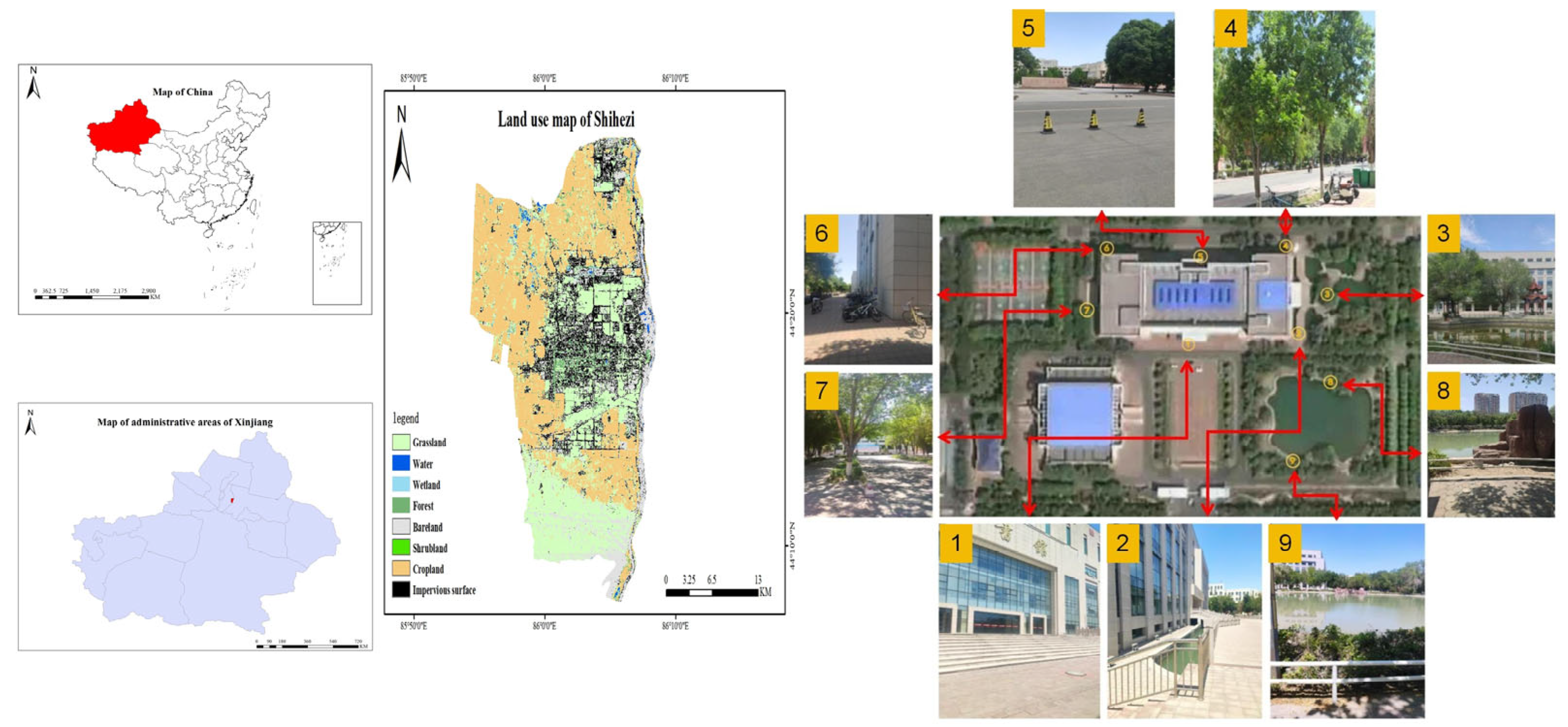


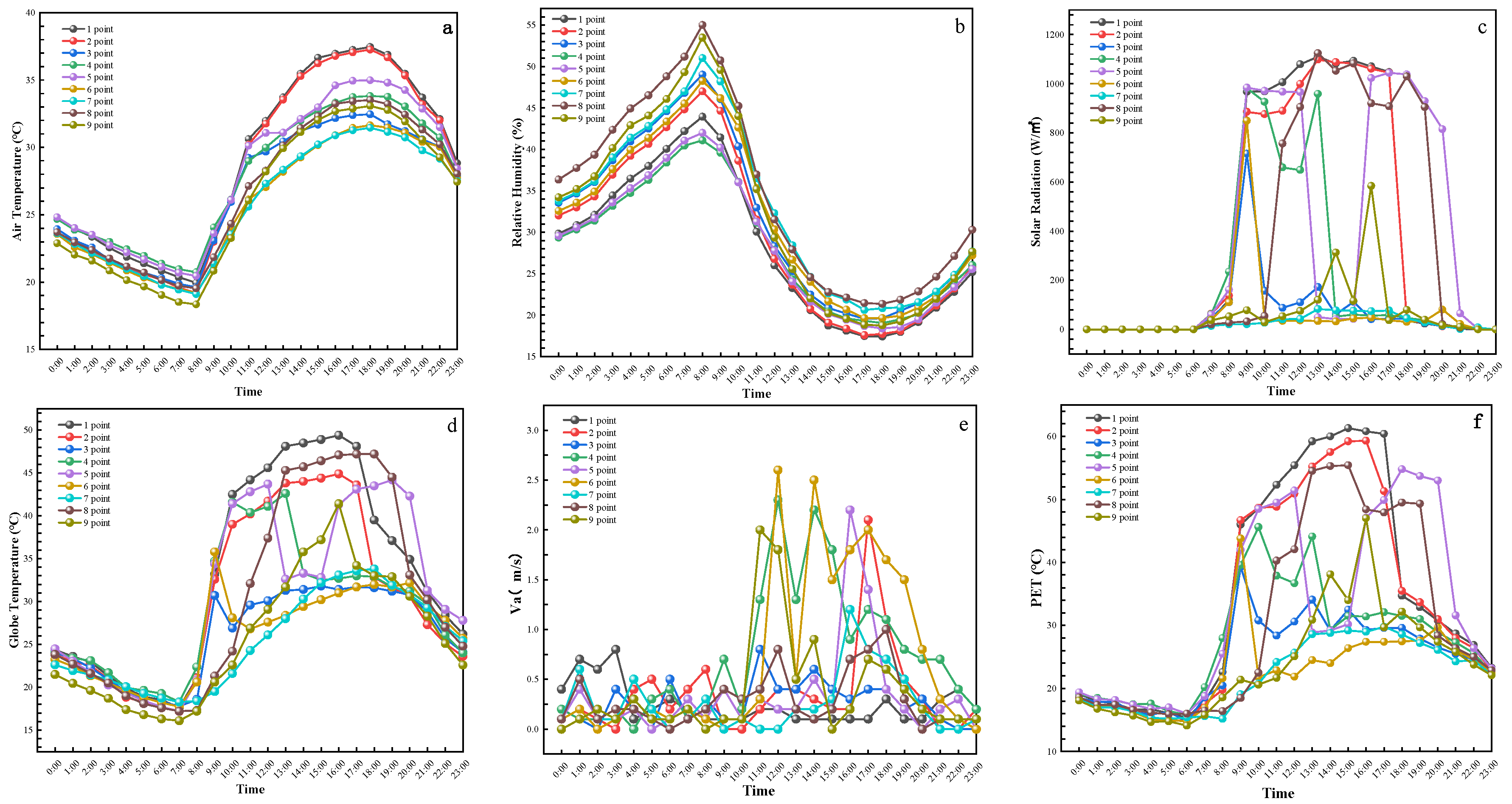
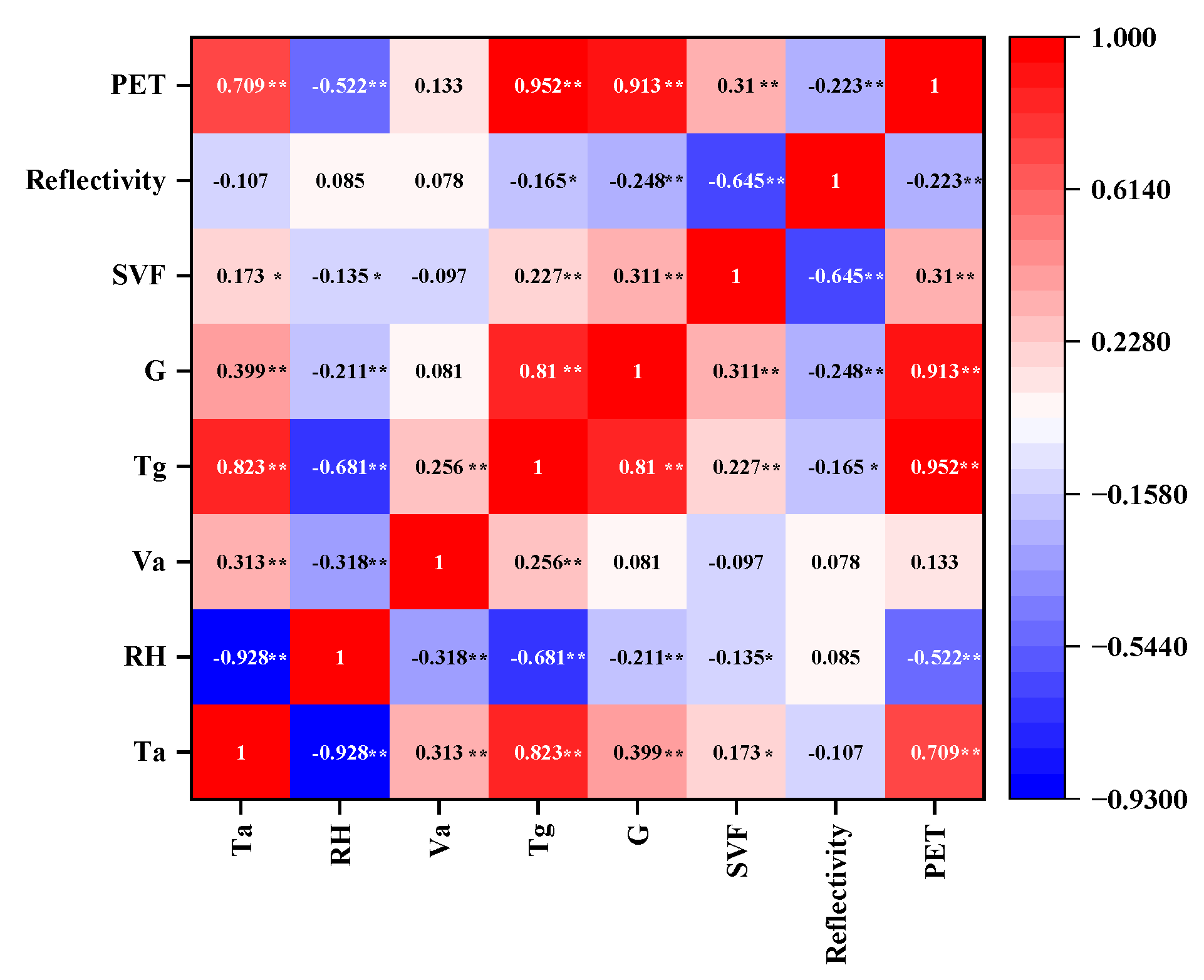

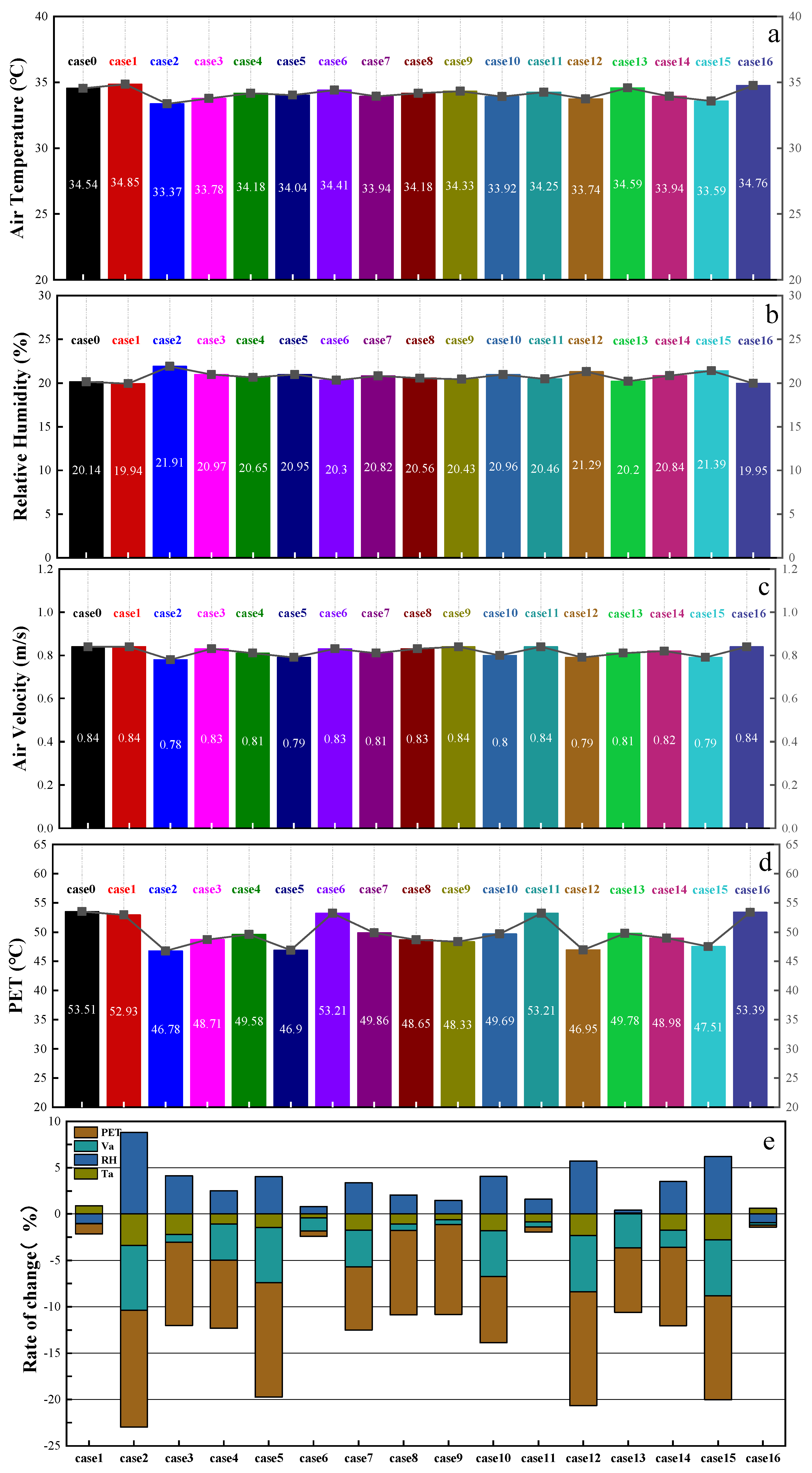
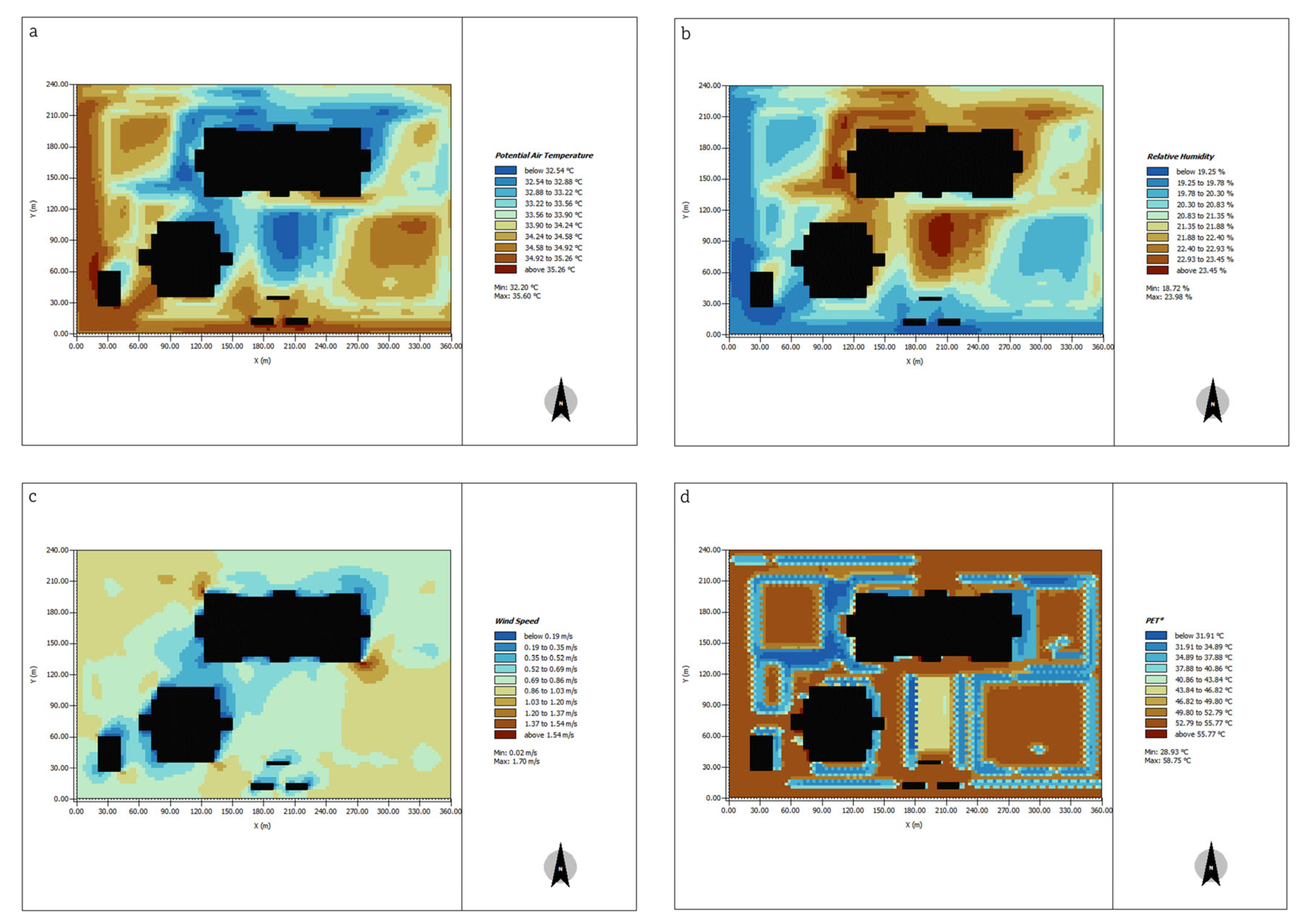
| Author | Year | City (Country) | Innovation Point | Research Method | Reference |
|---|---|---|---|---|---|
| Brozovsky et al. | 2020 | Trondheim (Norway) | Assessing the impact of microclimates on energy demand | Empirical + ANSYS Fluent | [20] |
| Li et al. | 2022 | Hong Kong (China) | Evaluating the microclimate performance of different public spaces in residential areas | Empirical | [21] |
| Alsaad et al. | 2020 | Weimar (Germany) | Determining the impact of facade greening on microclimates | Empirical + ENVI-met | [22] |
| Qi et al. | 2021 | Qingdao (China) | Identifying the impact of spatial morphology on microclimates | Empirical + ENVI-met | [23] |
| Li et al. | 2018 | Hong Kong (China) | Determining the influence of summer microclimate changes on human thermal perception | Empirical + Questionnaire Survey | [24] |
| Monitoring Point | Location | Underlying Surface Nature | Distance from Water Bodies | SVF | Fish-Eye Image |
|---|---|---|---|---|---|
| 1 | South gate of the library | Paved bricks | 68 m | 0.871 | 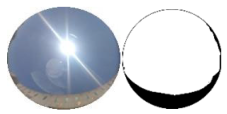 |
| 2 | Southeast corner of the library | Paved bricks | 3 m | 0.796 |  |
| 3 | Lake center island on the east side of the library | Paved bricks | - | 0.375 | 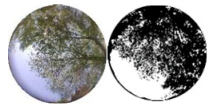 |
| 4 | Northeast corner of the library | Grass | 20 m | 0.332 |  |
| 5 | North gate of the library | Asphalt | 100 m | 0.749 |  |
| 6 | Northwest corner of the library | Paved bricks | 170 m | 0.383 |  |
| 7 | Under the trees at the west gate of the library | Grass | 185 m | 0.155 |  |
| 8 | North side of Shuxiang Lake | Paved bricks | 1 m | 0.384 | 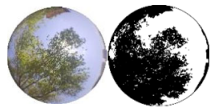 |
| 9 | Southwest side of Shuxiang Lake | Grass | 1 m | 0.510 | 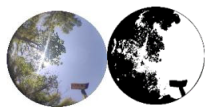 |
| Variable | Value | Model |
|---|---|---|
| Study site | Shihezi |  |
| Longitude, latitude | 86°30′ E,44°18′ N | |
| Time zone | CET/UTC + 6 | |
| Simulation date | 3 July 2023 | |
| Simulation duration | 24 h | |
| Start time | 00:00 am | |
| Domain size | 120 × 80 × 25 | |
| Mesh size | 3 × 3 × 2 m | |
| Wind speed | 1.1 m/s | |
| Wind direction | 225° | |
| Cloud cover | 0 | |
| Select meteorology | Simple Forcing | |
| Roughness | 0.1 |
| Evaluation Indicator | Unit | Factors Considered | References |
|---|---|---|---|
| PMV | - | Human factors, thermal environmental elements | [29] |
| UTCI | °C | Dry temperature, relative humidity, solar radiation, and wind speed, considered as reference environmental temperatures causing strain | [30] |
| SET | °C | Skin temperature and humidity | [31] |
| PET | °C | Based on the Munich Personal Energy Balance Model | [32] |
| Vegetation Type | Average Height (m) | Average Diameter at Breast Height (cm) | Height-Diameter Ratio | Average Crown Area (m2) |
|---|---|---|---|---|
| Grass | 0.25 | - | - | - |
| Large-leaved white wax | 10.6 | 24.4 | 0.4 | 59.3 |
| White elm | 9.7 | 23.9 | 0.4 | 58.9 |
| Chinese pine | 9.3 | 16.2 | 0.6 | 25.6 |
| Scheme | Factor 1 | Factor 2 | Factor 3 |
|---|---|---|---|
| Case 0 | 4 | 2 | - |
| Case 1 | 1 | 1 | 1 |
| Case 2 | 1 | 2 | 2 |
| Case 3 | 1 | 3 | 3 |
| Case 4 | 1 | 4 | 4 |
| Case 5 | 2 | 1 | 2 |
| Case 6 | 2 | 2 | 1 |
| Case 7 | 2 | 3 | 4 |
| Case 8 | 2 | 4 | 3 |
| Case 9 | 3 | 1 | 3 |
| Case 10 | 3 | 2 | 4 |
| Case 11 | 3 | 3 | 1 |
| Case 12 | 3 | 4 | 2 |
| Case 13 | 4 | 1 | 4 |
| Case 14 | 4 | 2 | 3 |
| Case 15 | 4 | 3 | 2 |
| Case 16 | 4 | 4 | 1 |
| Author | Research Location | PET Neutral Temperature or Comfort Range | Reference |
|---|---|---|---|
| Hirashima, SQD | Belo Horizonte | Neutral PET: 27.7 °C in summer and 15.9 °C in winter | [36] |
| Ribeiro, KFA | Cuiab’ a-MT | Comfortable range: between 23.01 and 34.64 °C | [37] |
| Cheng, B | Mianyang | Neutral PET: 27.0 °C in summer, 23.2 °C in autumn, and 17.3 °C in winter | [38] |
| Roshan, G | Iran | Comfortable range: between 18.9 and 22.5 °C | [39] |
| Li, JX | Xishuangbanna | Neutral PET: 27.3 °C; comfortable range between 17.67 and 36.9 °C; most comfortable range 25~35 °C | [40] |
| Guo, W | Chengdu | Neutral PET: 25.0 °C in summer | [41] |
| Thermal Perception | PET (°C) | |
|---|---|---|
| Standard Division [43] | Research Area Division | |
| Slightly cool | 13–18 | 23.59–27.44 |
| Comfortable | 18–23 | 27.44–31.28 |
| Slightly warm | 23–29 | 31.28–35.13 |
| Warm | 29–35 | 35.13–38.98 |
| Hot | 35–41 | 38.98–42.82 |
| Very hot | >41 | >42.82 |
Disclaimer/Publisher’s Note: The statements, opinions and data contained in all publications are solely those of the individual author(s) and contributor(s) and not of MDPI and/or the editor(s). MDPI and/or the editor(s) disclaim responsibility for any injury to people or property resulting from any ideas, methods, instructions or products referred to in the content. |
© 2024 by the authors. Licensee MDPI, Basel, Switzerland. This article is an open access article distributed under the terms and conditions of the Creative Commons Attribution (CC BY) license (https://creativecommons.org/licenses/by/4.0/).
Share and Cite
Xie, H.; Li, J.; Cai, Y. Optimization of External Environment Design for Libraries in Hot and Dry Regions during Summer. Sustainability 2024, 16, 743. https://doi.org/10.3390/su16020743
Xie H, Li J, Cai Y. Optimization of External Environment Design for Libraries in Hot and Dry Regions during Summer. Sustainability. 2024; 16(2):743. https://doi.org/10.3390/su16020743
Chicago/Turabian StyleXie, Hongkai, Jie Li, and Yongbin Cai. 2024. "Optimization of External Environment Design for Libraries in Hot and Dry Regions during Summer" Sustainability 16, no. 2: 743. https://doi.org/10.3390/su16020743
APA StyleXie, H., Li, J., & Cai, Y. (2024). Optimization of External Environment Design for Libraries in Hot and Dry Regions during Summer. Sustainability, 16(2), 743. https://doi.org/10.3390/su16020743







